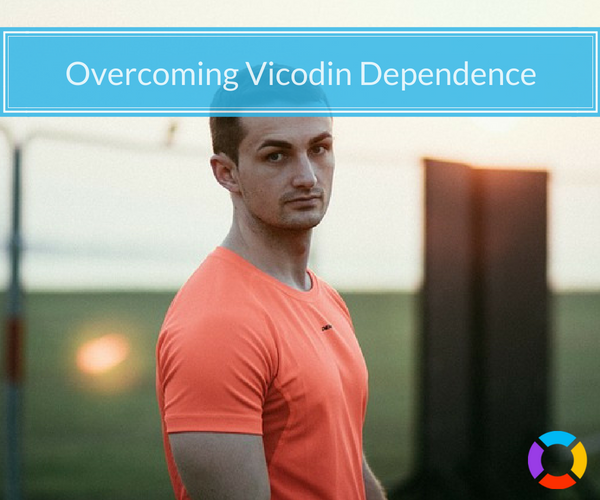Vicodin Detox: Withdrawal Symptoms, Timeline & Treatment Options

Maybe you were prescribed Vicodin after a dental procedure. Or your loved one first used it while recovering from surgery. It’s a commonly prescribed opioid, and it’s commonly misused. In 2023, 8.6 million Americans reported misusing prescription opioids, such as Vicodin. Fortunately, Vicodin detox and follow-up Vicodin rehab are available.
The following is a comprehensive guide to what you need to know about Vicodin, what you can expect from Vicodin withdrawal, and what Vicodin detox treatment options are offered.
Find outpatient Vicodin detox programs by calling us today!
What Is Vicodin? (And Why Is It Addictive)
Vicodin, the brand name for the combination of hydrocodone and acetaminophen, is a semi synthetic opioid pain medication. It was first developed in 1978 and was officially approved for use in the United States in 1983.
It is commonly prescribed to treat moderate to severe pain and is classified as a Schedule ll drug under the Controlled Substances Act. While useful in the short term, Vicodin has a high potential for abuse, dependence and overdose.
In addition to Vicodin’s pain-relieving properties, it also produces feelings of euphoria, contentment and relaxation, increasing its potential for misuse and dependence. Even when used as prescribed, Vicodin can cause some short and long-term side effects.
Short term Effects of Vicodin Use
- Decreased perception of pain
- Dizziness
- Drowsiness
- Lightheadedness
Long term Risks of Vicodin Use
- Physical and mental dependence
- Liver damage
- Impaired vision
- Dry nose and mouth
- Gastrointestinal distress
- Suicidal behaviors or ideation
- New or worsening mental illness
- Financial, relationship or employment turmoil
- Social withdrawal and isolation
Signs of Vicodin Addiction & Dependence
A person with Vicodin addiction can exhibit a wide range of behavioral, physical, and psychological symptoms. These include:
Behavioral Symptoms
- Taking Vicodin more often or in larger amounts than prescribed
- Using it for non-pain-related reasons
- Hiding pills, lying about use or becoming secretive about use
- Neglecting work, school or family responsibilities
- Doctor shopping to obtain extra prescriptions
- Continuing to use regardless of problems with health, relationships or the law
Physical Symptoms
- Needing higher doses for the same pain relief or effect
- Constricted or pinpoint pupils
- Drowsiness or nodding off
- Slurred speech or slower reaction times
- Itching
- Flushing Skin
- Constipation
- Unexplained weight loss
- Poor hygiene
Psychological Symptoms
- Strong cravings for the drug
- Mood swings, irritability or anxiety
- Memory issues or difficulty with concentration
- Depression
- Feeling unable to function without the drug
If you or someone you care about thinks they may have an addiction to Vicodin, take this quiz. This will tell you how to know if you’re addicted to Vicodin and what next steps to take to get support.
What Happens During Vicodin Withdrawal?
Vicodin withdrawal symptoms can begin within 6 to 12 hours after the last dose. The severity of symptoms varies from person to person and can include both physical and psychological symptoms.
Vicodin Withdrawal Symptoms
- Anxiety, irritability, mood swings, depression and confusion
- Insomnia
- Dilated pupils
- Tearing
- Yawning
- Runny nose
- Nausea, vomiting and diarrhea
- Changes in appetite
- Tremors
- Hyperreflexia (Abnormally heightened reflexes)
- Muscle spasms
- Bone and muscle pain
- Tachycardia (fast pulse)
- Hypertension (high blood pressure)
- Hyperthermia (high body temperature)
- Tachypnea (rapid breathing)
- Sweating
- Goosebumps
The severity of Vicodin withdrawal symptoms can range from mild to severe and is impacted by duration of use, dose, genetics, age, overall health, co-occurring disorders and metabolism.
While Vicodin withdrawal can be uncomfortable, programs are available that provide the support you or a loved one needs to detox safely and comfortably.
While some people can successfully quit cold turkey, gradually tapering the dose and having close medical support and supervision are highly recommended, especially for individuals with long-term, heavy use of Vicodin.
Vicodin Withdrawal Timeline: What to Expect
Most individuals going through Vicodin withdrawal will begin to feel symptoms within 6 to 12 hours after the last dose. However, Vicodin detox duration and the severity of withdrawal may be different from person to person.
Vicodin Withdrawal Symptoms Timeline
Early Vicodin Withdrawal
- Symptoms begin within 6 to 12 hours after the last dose
Early Acute Vicodin Withdrawal
- Typically 1 to 3 days after the last dose
- Symptoms usually peak and are most severe during this time
Acute Vicodin Withdrawal
- Typically 5 to 7 days after the last dose
- Symptoms gradually improve during this time
Protracted Vicodin Withdrawal
- Individuals with heavy Vicodin use may experience protracted symptoms that can last for weeks or months and are referred to as post acute withdrawal syndrome or PAWS.
- PAWS symptoms include:
- Anxiety, insomnia, irritability, cravings, lack of interest, lack of enjoyment
Is It Safe to Detox from Vicodin at Home?
Individuals with mild addiction to Vicodin can detox from Vicodin at home. However, addiction professionals may recommend medication and close medical supervision to ensure the safest and most comfortable process.
Individuals who have a long history of Vicodin use or have used Vicodin in larger doses can face some withdrawal symptoms that can be quite uncomfortable and in some cases, life threatening.
In some cases, an individual in the detox process will return to use to stop the negative symptoms of withdrawal, increasing the risk of drug overdose due to a decreased tolerance to the drug. For this reason, an inpatient detox program where early intervention and close medical monitoring are used is highly recommended.
There are treatment programs across the country that provide the support needed to safely and successfully detox from Vicodin. Reaching out is the first step toward recovery.
Find professional Vicodin detox near you.
Treatment Options: Inpatient vs. Outpatient Vicodin Detox
As you’re searching for Vicodin detox near me, you’ll discover both inpatient and outpatient treatment options. Here’s a breakdown of the main differences between the two types of Vicodin detox centers.
| Aspect | Inpatient Vicodin Detox | Outpatient Vicodin Detox |
| Benefits | -Around the clock medical supervision reduces the risk of severe withdrawal complications. -Immediate access to medications for system relief -Structured, substance-free environment -Emotional and peer support are available 24/7 -Removes access to Vicodin and other substances, lowering the risk of relapse during the detox process | -More affordable than an inpatient stay -Flexibility to maintain work, school or family responsibilities -Ability to recover in a familiar environment -Privacy (not staying in a facility) -Can be effective for mild dependency and for people with strong support |
| Risks | -Higher cost, may not be covered by insurance -Requires time away from home, work or school -Less privacy due to living with staff and peers -Possible emotional stress from being away from home | -Limited medical monitoring -Greater temptation and access to Vicodin and other opioids -Less structure, making relapse more likely in early recovery -Requires strong self-discipline and supportive people -Delayed emergency care if needed |
| Best for… | -People with moderate to severe Vicodin addiction -Those with a history of relapse -Individuals at risk for severe withdrawal symptoms, including seizure activity, severe anxiety or depression -People without a stable or sober living environment | -People with mild to moderate Vicodin dependence -Those with strong family and/or peer support -Individuals with work, school or caregiving obligations -Those at low risk for medical complications |
Medications for Vicodin Withdrawal Relief
Several medications can be used during the Vicodin detox process and for long-term medication assisted treatment (MAT) for Vicodin addiction. These vicodin withdrawal treatment medications include:
- Buprenorphine or Suboxone binds to and activates mu-opioid receptors in the brain. It works by decreasing cravings and withdrawal symptoms and by blocking opioid drugs from attaching to these receptors.
- Clonidine is an antihypertensive drug that works by suppressing withdrawal symptoms, including lowering blood pressure and heart rate, both of which, when raised, can cause anxiety or mood swings. As well, it helps to alleviate sweating and muscle aches often experienced during Vicodin detox.
- Methadone is a long-acting full opioid agonist that works by reducing Vicodin cravings and withdrawal symptoms and blocks the effects of opioids. It can be used during the early detox phase as well as for long-term maintenance treatment of Vicodin addiction.
- Lofexidine is an alpha-2 agonist that is used to manage acute withdrawal symptoms. It works by decreasing sympathetic nervous system activity. It can be used for up to 14 days during the acute detox phase.
Behavioral Therapy & Aftercare Following Detox
Detox is just the first step toward a future in recovery. Once stabilization has been achieved, an individual must participate in a comprehensive treatment program to make continued steps toward long-term sobriety.
This Vicodin addiction treatment addresses the contributing factors that encouraged the development of Vicodin addiction. It also provides the tools to develop healthy coping skills and a relapse prevention plan.
These programs include:
- Outpatient care
- Intensive outpatient programs (IOPs)
- Partial hospitalization programs (PHPs)
- Aftercare
- 12 Step support groups
These Vicodin rehab resources utilize a mix of psychotherapy approaches to meet each person’s unique treatment needs.
Psychotherapies, or talk therapies, include cognitive behavioral therapy (CBT), contingency management and family therapy. These help an individual to change negative thought patterns and develop healthy coping skills, build relationships and improve communication.
Should You Quit? Take the Vicodin Detox Readiness Quiz
Do you need Vicodin detox or Vicodin rehab? Find out with this self-assessment.
Take the Vicodin Detox Readiness Quiz
FAQs: Vicodin Withdrawal and Detox
Typically, an individual can detox from Vicodin within 5 to 7 days. Individuals with heavy Vicodin use may experience protracted symptoms, also referred to as post acute withdrawal syndrome (PAWS), which can last for weeks or months after acute detox.
-Anxiety, irritability, mood swings, depression and confusion
-Insomnia
-Dilated pupils
-Tearing
-Yawning
-Runny Nose
-Nausea, vomiting and diarrhea
-Changes in appetite
-Tremors
-Hyperreflexia (abnormally heightened reflexes)
-Muscle spasms
-Bone and muscle pain
-Tachycardia (fast pulse)
-Hypertension (high blood pressure)
-Hyperthermia (high body temperature)
-Tachypnea (rapid breathing)
-Sweating
-Goosebumps
Yes, but it is not recommended for anyone who may be at risk of complications of Vicodin withdrawal.
The best and safest way to detox from Vicodin is under medical supervision, either in a residential treatment facility or through a closely monitored outpatient program. Individuals who detox with medical support have a decreased risk of relapse compared to those who have gone cold turkey.
The safest way to taper off Vicodin is to work with a medical provider. Typically, tapering involves reducing the dose by 10-20% every 1 to 2 weeks.
There are several ways to get help for Vicodin addiction. Individuals can work with their primary care providers to determine the appropriate level of care needed to meet their unique needs.
Additionally, online resources like Detox.com offer a database that allows you to filter treatment programs by setting, medications offered, level of care, insurance, and payment options. You can find the contact information for a program that appeals to you.



